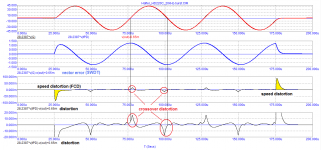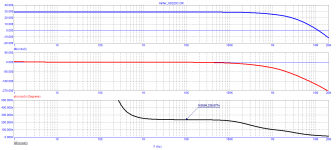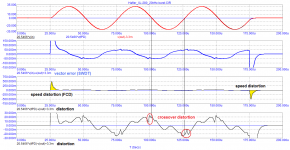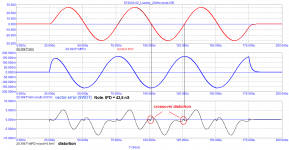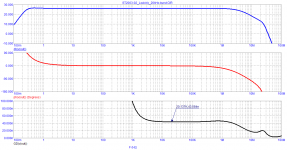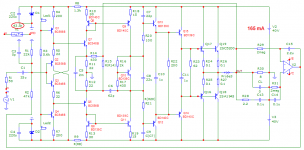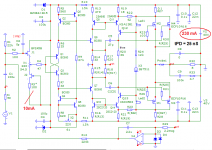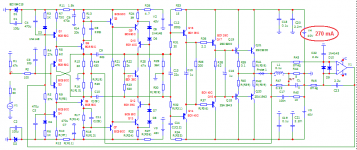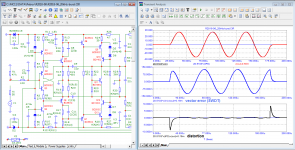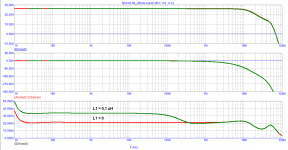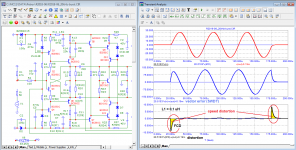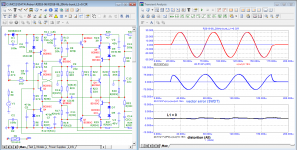Pagos, petr-2009 is author of many really good sounding amplifiers, also he provide lot of articles in russian and ukrainian magazines.
Maybe - but all other amps in the world don't sound like crap so there isn't anything special about petr amps. If it really was, we would have heard about them in the big world - no?
If petr's amps sound good and other amps sound equally good or better, there isn't anything special about his amps.
By this follows that the thesis he drives is not significant for the sound of amps or the world and amps would all look different. But they dont.
His presence here seem to be just a hidden advertisement for a product - but we aint buying it. And this should probably be in the commercial sector...?
//
Last edited:
And I would like a house on the shore of a warm sea and a bank account with seven zeros, but unfortunately not all of our dreams are destined to come truepetr-2009 is author of many really good sounding amplifiers, also he provide lot of articles in russian and ukrainian magazines.
Since I see that you have a very negative attitude towards him, I would like that you show us your developments: your schemes, simulations, real prototypes, etc.
If you do not have such, it seems very frivolous to criticize his developments, because they really sound very good.
I've make some of them and they showed excellent results of measurements and auditions.
So, please stop being rude to him, it does not make a good impression.
You know what really doesn't make a good impression? To act as a lawyer without having read the case materials and without understanding the law.
According to your own course of reasoning, you will have the right to assert and say something only after you show your developments and real results? Don't you find this line of thought strange?
Pagos, petr-2009 is author of many really good sounding amplifiers
Where are the receipts?
Compare the 3 characteristics of Group Delay and the dependence of speed distortion on its magnitude and behavior outside the audio band.
And although the signal transmission delay in the Hafler amplifier can be adjusted over a wide range (from zero to hundreds of nanoseconds), nevertheless, at a frequency of 450 kHz, the Group Delay rises to l μs. It is this rise that is responsible for speed distortion.
As practice shows, in the absence of boost and Group Delay <= 100 nS, speed distortions are commensurate with other types of distortions and do not significantly affect the color of the sound.
And although the signal transmission delay in the Hafler amplifier can be adjusted over a wide range (from zero to hundreds of nanoseconds), nevertheless, at a frequency of 450 kHz, the Group Delay rises to l μs. It is this rise that is responsible for speed distortion.
As practice shows, in the absence of boost and Group Delay <= 100 nS, speed distortions are commensurate with other types of distortions and do not significantly affect the color of the sound.
Attachments
Last edited:
Please forgive me. I shouldn't say this. Your activity here doesn't materially affect me in any way. But I am very tired of seeing your posts. I wish you would stop.
and you forgive me. If you don't understand anything, then just walk by or sit down and rest if you are tiredPlease forgive me. I shouldn't say this. Your activity here doesn't materially affect me in any way. But I am very tired of seeing your posts. I wish you would stop.
and you forgive me. If you don't understand anything, then just walk by or sit down and rest if you are tired
There are 786 posts in this thread. Ample time to make your case. I have enough background (trust me) to follow the material. There are many other smart people here, whom I respect, more knowledgeable than me for sure, and you haven't convinced them either. At this point, whatever insight you may have, it's ceased to be useful or entertaining. You've become a troll.
You've tried hard. It's time to pack up and move on.
I used to enjoy arguing on forums. I don't enjoy it anymore. I just wanted you to know how I feel. I have nothing else to say.
John Curl doesn't think soYou've become a troll.
JC-3 class-a power amp
I hope that Bob Cordell too
Hafler DH-200/220 Mods
@petr_2009,
I've been lurking for a while and at the same time didn't have much time available to post. But can I perhaps make a suggestion?
I'm sure you're familiar with the saying 'the proof of the pudding is in the eating'. How about you share with us one of your amplifier designs that encompasses all the things you clearly feel are important. I'm sure myself and others would be happy to simulate that down to the picosecond realm and see what we're dealing with here exactly, frankly if I like what I see I'll even build one up and do some real world measurements.
Sounds like a plan? As clearly this topic needs some new incentive if you want to convince people.
I've been lurking for a while and at the same time didn't have much time available to post. But can I perhaps make a suggestion?
I'm sure you're familiar with the saying 'the proof of the pudding is in the eating'. How about you share with us one of your amplifier designs that encompasses all the things you clearly feel are important. I'm sure myself and others would be happy to simulate that down to the picosecond realm and see what we're dealing with here exactly, frankly if I like what I see I'll even build one up and do some real world measurements.
Sounds like a plan? As clearly this topic needs some new incentive if you want to convince people.
Which post was linked to? I didn't see anything. Write the post number or corrected link. I doubt Bob could support your position, sorry.I hope that Bob Cordell too
Hafler DH-200/220 Mods
SSassen is right, fully agrees with him and is ready to assist in this if necessary, as before. Consider this option.
In order to increase the output power, I increased the supply voltage from + -27 V to + -40 V and added paired transistors. The rest of the changes are almost insignificant. Here is a schematic diagram of the model that was tested.
fagos, as for Bob Cordell, he asked me a question about speed distortions, I answered, there were no objections or comments (remark).
fagos, as for Bob Cordell, he asked me a question about speed distortions, I answered, there were no objections or comments (remark).
Attachments
Let me notice that tactful silence is not a sign of consent.fagos, as for Bob Cordell, he asked me a question about speed distortions, I answered, there were no objections or comments (remark).
The scheme is higher in your opinion worthy to present you and your views at the moment? Are you ready to make it and carry out real measurements to confirm your ideas, how does SSASSEN offer?
or this amplifier circuit
fagos, read carefully what ssassen wrote and do not compose for him
Lozitsky's amplifier was repeated by thousands of radio amateurs and confirmed its parameters. The circuits proposed by me are also with a current feedback and have similar parameters.
fagos, read carefully what ssassen wrote and do not compose for him
Lozitsky's amplifier was repeated by thousands of radio amateurs and confirmed its parameters. The circuits proposed by me are also with a current feedback and have similar parameters.
Attachments
Last edited:
In order to increase the output power, I increased the supply voltage from + -27 V to + -40 V and added paired transistors. The rest of the changes are almost insignificant. Here is a schematic diagram of the model that was tested.
fagos, as for Bob Cordell, he asked me a question about speed distortions, I answered, there were no objections or comments (remark).
I think this is what Cordell answered:
"Mere propagation delay through the amplifier is of no consequence and cannot be heard."
I think this is what Cordell answered:
"Mere propagation delay through the amplifier is of no consequence and cannot be heard."
With all due respect to Bob, he's wrong, see
Hafler DH-200/220 Mods
for this you need to understand the essence of the Hafler and Carver method and how to apply it correctly
on a number of examples, I showed that measurements on sinusoidal signals (in steady state) are equivalent to measuring THD. The tests should use a 10 kHz triangular signal, a square wave, 1/3 octave noise, or 10 ... 20 kHz bursts. I've shown enough examples to understand the difference.
Certainly he es wrong. You should offer your superior knowledge to him😛😛😛With all due respect to Bob, he's wrong, see
Hafler DH-200/220 Mods.
John Curl and Graham Maynard have repeatedly talked about the detrimental effect of an amplifier's choke on the output on sound quality. But apart from ridicule, it caused nothing.
Note the choke and non-choke Bode diagram. Some authors (in particular, fagos) argue that they do not need the Group Delay graph, they say that the frequency response and phase response are enough. But on the frequency response and phase response, there are no obvious changes with the addition of a choke.
Let's consider this influence on two tests.
A choke of even a negligible value (0.1 μH) shunted with a 0.22 Ohm resistor has a significant effect on both the Group Delay value, its behavior beyond the audio range, and speed distortion. And what about chokes with inductance of 10 ... 15 μH, which are not uncommon in amplifiers. Without a choke, speed distortion is negligible - lower than other types of distortion.
John, you said you'd have the last laugh. I think the time has come
Note the choke and non-choke Bode diagram. Some authors (in particular, fagos) argue that they do not need the Group Delay graph, they say that the frequency response and phase response are enough. But on the frequency response and phase response, there are no obvious changes with the addition of a choke.
Let's consider this influence on two tests.
A choke of even a negligible value (0.1 μH) shunted with a 0.22 Ohm resistor has a significant effect on both the Group Delay value, its behavior beyond the audio range, and speed distortion. And what about chokes with inductance of 10 ... 15 μH, which are not uncommon in amplifiers. Without a choke, speed distortion is negligible - lower than other types of distortion.
John, you said you'd have the last laugh. I think the time has come
Attachments
- Home
- Amplifiers
- Solid State
- Musings on amp design... a thread split
